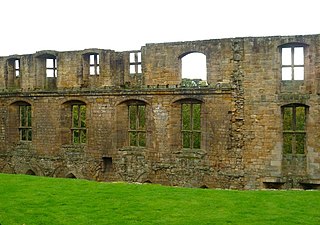Castle Huntly is a castle in Scotland, now used as a prison under the name HMP Castle Huntly. It is located approximately 7 miles (11 km) west of Dundee in the Carse of Gowrie, Perth and Kinross, close to the shore of the Firth of Tay, and can be seen from the main road linking Dundee and Perth. The castle sits on top of a rocky outcrop surrounded by what is now farmland. In ancient times this land was marshy wilderness and the decision to locate the castle on the rock may have been taken with a view to the castle's defensive position in mind.

Esther Inglis (1571–1624) was a skilled member of the artisan class, as well as a miniaturist, who possessed several skills in areas such as calligraphy, writing, and embroidering. She was born in 1571 in either London or in Dieppe and was later relocated to Scotland, where she was later raised and married. Sharing similarities with Jane Segar, Inglis always signed her work and frequently included self-portraits of herself in the act of writing. However, unlike Jane Segar, Inglis successfully established a career based on manuscript books created for royal patrons. Over the course of her life, Inglis composed around sixty miniature books that display her calligraphic skill with paintings, portraits, and embroidered covers. She mostly dedicated her books to the monarchs, Elizabeth I and James VI and I, and people in power during their reign. She died around 1624, at the age of 53.

George Keith, 5th Earl Marischal (c. 1553–1623) was a Scottish nobleman and Earl Marischal. He succeeded as earl on 7 October 1581, upon the death of his grandfather, William Keith, 4th Earl Marischal.

The Skelmorlie Aisle of Largs Old Kirk is the remains of a church in the town of Largs, Ayrshire, Scotland.

Scottish renaissance painted ceilings are decorated ceilings in Scottish houses and castles built between 1540 and 1640. This is a distinctive national style, though there is common ground with similar work elsewhere, especially in France, Spain and Scandinavia. An example in England, at Wickham, Hampshire, was recorded in 1974. There are records of over 100 examples, and a much smaller number of painted ceilings survive in-situ today. Some salvaged painted beams and boards are stored by Historic Environment Scotland. The paintings at Crathes Castle, dating from 1597 and 1602 are probably the best known.

Pierre Quesnel was a 16th-century French artist who worked in Scotland, before returning to Paris with his family after the death of James V of Scotland.

Adrian Vanson was a portrait artist who worked for James VI of Scotland.

Portrait painting in Scotland includes all forms of painted portraiture in Scotland, from its beginnings in the early sixteenth century until the present day. The origins of the tradition of portrait painting in Scotland are in the Renaissance, particularly through contacts with the Netherlands. The first portrait of a named person that survives is that of Archbishop William Elphinstone, probably painted by a Scottish artist using Flemish techniques around 1505. Around the same period Scottish monarchs turned to the recording of royal likenesses in panel portraits, painted in oils on wood. The tradition of royal portrait painting in Scotland was probably disrupted by the minorities and regencies it underwent for much of the sixteenth century. It began to flourish after the Reformation, with paintings of royal figures and nobles by Netherlands artists Hans Eworth, Arnold Bronckorst and Adrian Vanson. A specific type of Scottish picture from this era was the "vendetta portrait", designed to keep alive the memory of an atrocity. The Union of Crowns in 1603 removed a major source of artistic patronage in Scotland as James VI and his court moved to London. The result has been seen as a shift "from crown to castle", as the nobility and local lairds became the major sources of patronage.
Andrew Halyburton or Haliburton was a Scottish merchant.
The tournament of the Wild Knight and the Black Lady was an event held twice in Edinburgh by James IV of Scotland, in June 1507 and May 1508.
Jerome, Hieronimo, or Girolamo Frescobaldi (1444–1517) was an Italian financier and textile merchant based in Bruges. He supplied luxury goods to the Scottish court and was described as a "very good friend to the King of Scots". The Frescobaldi family and company, based in Florence, were involved in artistic commissions in England and Scotland. Jerome Frescobaldi was involved in the wool trade with Tommaso Portinari and his sons, and marketed spices obtained by Portuguese traders.
James Hommyll, was a wealthy merchant in Edinburgh.
Apollonia Kickius was a painter working in Scotland in the 17th century. She is one of only three women painters known to be working in Scotland prior to 1700 and is the sole woman in Scotland documented as working in the building trades from the 17th to mid 19th century.
John Workman or Warkman was a decorative painter working in Edinburgh.
Walter Binning, or Bynning was a painter in 16th-century Edinburgh.

Valentine Jenkin or Jenkins was an English decorative painter working in Scotland in the 17th century.

Isobel Colt was the nurse of Robert Stuart, Duke of Kintyre and Lorne, a son of James VI of Scotland and Anne of Denmark.
Adrian or Adriaan Damman of Bysterveldt a native of Ghent, He was a diplomatic agent of the Dutch Republic in Scotland in the 1590s. Damman was an author, and taught at the University of Edinburgh.

James Grant, 7th of Freuchie (1616–1663) was a Scottish landowner, the seventh Laird of Freuchie. He was the 18th Chief of Clan Grant.

John Grant of Freuchie (1596-1637) was a Scottish landowner.











